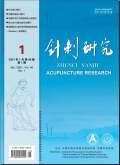针刺研究2024,Vol.49Issue(10):1030-1039,10.DOI:10.13702/j.1000-0607.20230618
基于HIF/VEGF/Notch信号通路探讨电针"百会""足三里"对脑缺血大鼠血管新生的影响
Effect of electroacupuncture at"Baihui"(GV20)and"Zusanli"(ST36)on angiogenesis in the brain of middle cerebral artery occlusion rats based on HIF/VEGF/Notch signaling pathway
摘要
Abstract
Objective To observe the effect of electroacupuncture(EA)on hypoxia-inducible factor(HIF)/vascular endothelial growth factor(VEGF)/Notch signaling pathway and related factors in rats with cerebral ischemia(CI),so as to explore its regulatory mechanism underlying improvement of CI by promoting cerebral microangiogenesis.Methods Fifteen male SD rats were randomly selected as the sham surgery(sham)group,while other 85 rats were used to prepare CI model according to the modified Zea-Longa method.The successful CI model rats(n=60)were randomly allocated to model,EA,EA+inhibitor,and inhibitor groups,with 15 rats in each group.EA stimulation(1 Hz/20 Hz,1-2 mA)was applied to"Baihui"(GV20)and right"Zusanli"(ST36)for 30 min,once a day for 7 days.Rats of the 2 inhibitor groups received intraperitoneal injection of YC-1(HIF-1α inhibitor,2.5 mg/kg),once a day for 7 days.The modified neurological severity scale(mNSS,including the motor[muscular state,abnormal movement],sensory[visual,tactile and proprioceptive],balance and reflex functions,0-18 points)was used to assess the rats'neurological deficit state.The percentage of cerebral infarct volume was measured after 2,3,5-triphenyl tetrazolium chloride(TTC)staining,and pathological changes of the ischemic penumbra cortex were observed after H.E.staining.The immunoactivity of CD34 was determined using immunohistochemistry,followed by calculating the microvascular density(MVD)in the ischemic penumbra cortex,and the expression levels of HIF-1α,VEGF,vascular endothelial growth factor receptor 2(VEGFR2),Notch1,and Delta like 4 ligand(DLL4)mRNAs and proteins in the ischemic penumbra of brain tissue were detected using real-time PCR and Western blot,respectively.Results In contrast to the sham group,the mNSS score,percentage of cerebral infarct volume,MVD,and expression levels of HIF-1α,VEGF,VEGFR2,Notch1 and DLL4 proteins and mRNAs were all significantly increased in the model group(P<0.01).In comparison with the model group,the mNSS score and percentage of cerebral infarct volume were significantly decreased in the EA group(P<0.01),and increased in the inhibitor group(P<0.01),and the MVD,and expression levels of HIF-1α,VEGF,VEGFR2,Notch1 and DLL4 proteins and mRNAs were further strikingly increased in the EA group(P<0.01),but obviously decreased in the inhibitor group(P<0.05,P<0.01).Comparison between EA and EA+inhibitor groups showed that the effects of EA were basically eliminated in lowering mNSS score and percentage of cerebral infarct volume(P<0.01),and in up-regulating MVD,and expression levels of HIF-1α,VEGF,VEGFR2,Notch1 and DLL4 mRNAs and proteins(P<0.01).The levels of mNSS score and percentage of cerebral infarct volume were markedly higher(P<0.01)in the inhibitor group than those in the EA+inhibitor group,while the MVD,expression levels of HIF-1α,VEGF,VEGFR2,Notch1 and DLL4 mRNAs and proteins were significantly lower in the inhibitor group than in the EA+inhibitor group(P<0.01),suggesting an elimination of EA after administration of HIF-1α inhibitor.H.E.staining showed loosened structure and disordered arrangement of neurons,swollen and vacuolized cells with ruptured nuclei,swollen and deformed microvessels in the ischemic penumbra of the brain tissue in the model group,which was improved in the EA group,including reduction of cellular swelling degree and vacuol-like changes,relatively intact of nuclei,and increase of new capillaries.Conclusion EA of GV20 and ST36 can improve neurological deficit and reduce cerebral infarct volume in CI rats,which may be associated with its functions in promoting angiogenesis in ischemic penumbra area and in up-regulating the activities of HIF/VEGF/Notch signaling pathway and related factors.关键词
缺血性脑卒中/电针/缺氧诱导因子/血管内皮生长因子/神经源性位点缺口同源蛋白信号通路/血管新生Key words
Ischemic stroke/Electroacupuncture/HIF/VEGF/Notch signaling pathway/Angiogenesis引用本文复制引用
杨悦悦,吴松,马素娜,关梦雅,王晶莹,任彬彬..基于HIF/VEGF/Notch信号通路探讨电针"百会""足三里"对脑缺血大鼠血管新生的影响[J].针刺研究,2024,49(10):1030-1039,10.基金项目
2022年度河南省中医药拔尖人才培养项目(No.2022ZYBJ09) (No.2022ZYBJ09)
中医药传承与创新人才工程项目(No.CZ0262-10-02) (No.CZ0262-10-02)
2023年度河南省中医药科学研究专项课题项目(No.2023ZY30010) (No.2023ZY30010)

